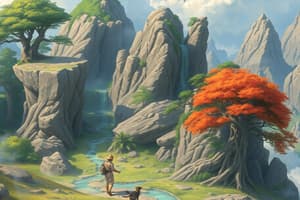Podcast
Questions and Answers
What are the factors that affect population size?
What are the factors that affect population size?
- Average per capita education level, average per capita disease rate, and hurricane frequency
- Average per capita food consumption, average per capita migration rate, and ozone layer thickness
- Average per capita income rate, average per capita emigration rate, and precipitation
- Average per capita birth rate, average per capita death rate, and immigration rate (correct)
What is the primary factor that determines if a population will increase in size?
What is the primary factor that determines if a population will increase in size?
- Intrinsic rate of increase (correct)
- Number of hurricanes in the region
- Average national income level
- Density-independent factors
Which layer of the atmosphere contains the ozone layer, which protects against ultraviolet (UV) radiation from the sun?
Which layer of the atmosphere contains the ozone layer, which protects against ultraviolet (UV) radiation from the sun?
- Troposphere
- Exosphere
- Mesosphere
- Stratosphere (correct)
What is the term for the maximum population that can be maintained for an indefinite time by a particular environment?
What is the term for the maximum population that can be maintained for an indefinite time by a particular environment?
Which type of competition involves certain dominant individuals obtaining an adequate supply of limited resources at the expense of others?
Which type of competition involves certain dominant individuals obtaining an adequate supply of limited resources at the expense of others?
What is the study of changes in population, focusing on how and why the numbers increase or decrease?
What is the study of changes in population, focusing on how and why the numbers increase or decrease?
Which ecological level consists of several different species interacting in a defined region?
Which ecological level consists of several different species interacting in a defined region?
What is the solid portion of the Earth called, which includes the crust and mantle?
What is the solid portion of the Earth called, which includes the crust and mantle?
Which of the following represents the liquid portion of the Earth, making up approximately 71% of the planet's surface?
Which of the following represents the liquid portion of the Earth, making up approximately 71% of the planet's surface?
Which term refers to the number of individuals of a species per unit of area or volume at a given time?
Which term refers to the number of individuals of a species per unit of area or volume at a given time?
Flashcards are hidden until you start studying
Study Notes
Population Ecology
- Multiple factors affect population size, including biotic and abiotic factors.
- The primary factor that determines if a population will increase in size is the availability of resources, such as food, water, and shelter.
Atmospheric Science
- The stratosphere is the layer of the atmosphere that contains the ozone layer, which protects against ultraviolet (UV) radiation from the sun.
Ecological Concepts
- The term "carrying capacity" refers to the maximum population that can be maintained for an indefinite time by a particular environment.
- Dominance competition is a type of competition where certain dominant individuals obtain an adequate supply of limited resources at the expense of others.
Population Dynamics
- Demography is the study of changes in population, focusing on how and why the numbers increase or decrease.
Ecological Levels
- An ecosystem consists of several different species interacting in a defined region.
Geology
- The lithosphere is the solid portion of the Earth, which includes the crust and mantle.
- The hydrosphere represents the liquid portion of the Earth, making up approximately 71% of the planet's surface.
Population Density
- Population density refers to the number of individuals of a species per unit of area or volume at a given time.
Studying That Suits You
Use AI to generate personalized quizzes and flashcards to suit your learning preferences.




